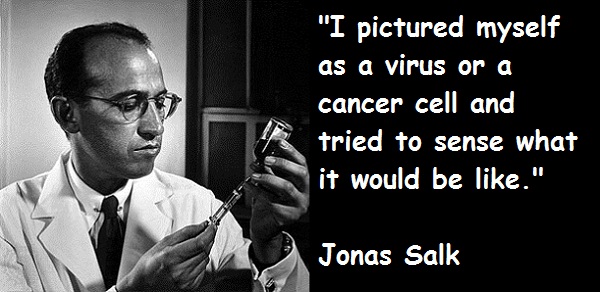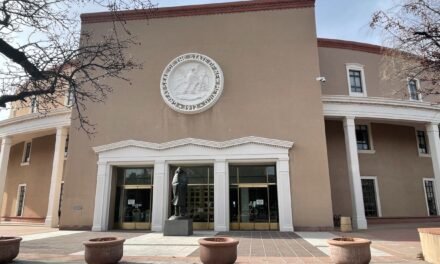
Jonas Salk: Polio Miracle Worker

Jonas Salk, as an M.D., was interested in research as a virologist, rather than in the actual practice of medicine. And he was willing to take risks to speed up and aid his research and seek outside funding to help his endeavors. This funding took him outside a somewhat sheltered world of academic research and into interaction with various advocacy groups.
Born in New York to Russian-Jewish immigrant parents, Salk received his medical degree in the city. He was able to research influenza, where the virus causing the disease had recently been discovered. Both government and medical authorities were very concerned that after a new world war, a catastrophic flu epidemic might occur, just as it did after World War I. Salk confirmed that the virus could be manipulated so that it could not infect, but still provide flu immunity.
By the 1940s and 1950s, the entire U.S. population was panicked by polio and eager to contribute to research to combat it. Only about 50 out of 100,000 population became infected with polio, which was about 10% of the child death rate from accidents. Nonetheless, despite these low rates, during summers, parents became frantic with worry over their children’s safety in pools and other public areas. When poliomyelitis struck, the victim could wind up with withered arms and legs, inability to walk, or in extreme cases, confinement in iron lungs. Many spent at least some time in wheelchairs and with leg braces. The courage of Franklin Roosevelt in living with the disease while remaining in public life led to his formation of the National Foundation for Infantile Paralysis, later known as the March of Dimes. This generated nationwide charitable fund-raising campaigns. At one time or another, over two-thirds of all Americans had contributed to the March of Dimes.
In addition to Roosevelt, many famous people had contracted polio, including the violist, Itzhak Perlman. Most recovered to a significant degree. In the summer of 1951, according to my mother, I might have suffered a mild case of polio. Perhaps too much tennis had been the real culprit, but my left arm and shoulder have always been weaker than my right.
By 1947, Salk was associated with the University of Pittsburgh School of Medicine. From his earlier research and that of others on the influenza virus, vaccines had controlled the disease after World War II. He hoped to use a similar approach to develop a vaccine to fight polio, also known to be virus caused.
But the polio virus had baffled researchers for many years. Finally, it was discovered that it was transmitted through fecal matter and nose and mouth secretions. These in turn led the virus to be housed in the intestines and then to move to the brain or spinal cord.
Salk continued his research and trials for eight years. During his work, he spent tens of millions on his trials and eventually, starting in 1954, used over one million children in testing the vaccine. The March of Dimes contributed substantially to Salk’s work, which constituted the most extensive clinical trial in medical history. His colleagues were amazed by the number of hours Salk worked each day, including weekends, without letup.
In early 1955, these human trials used a polio vaccine that effectively protected patients from effects of the virus. The public became riveted on Salk’s clinical trials, even before any results could be ascertained. News of Salk’s successful results was at last released to the public on April 12, 1955. As a result, he became a national hero, and President Eisenhower presented him with a citation. Some in Congress even called for a national holiday to be proclaimed in his honor. Salk’s reputation was enhanced when he declined to seek a patent on his vaccine or profit in any way from his invention. He also declined a ticker tape parade in his honor. To one interviewer’s question, he answered: “Could you seek a patent for the sun?”
Even while his vaccine started to be used, Salk continued working for several years with techniques designed to further improve the vaccine’s effectiveness and address some critical questions. For example: How long will immunity last from administering the vaccine? Are there any children whose bodies, due to physical defects or other genetic factors, would resist immunization?
Some controversy developed over use of Salk’s injected vaccine (from a killed polio virus) versus a competing version taken orally. In the U.S., public health authorities elected to distribute the oral version, known as the Sabin version, which was made from a live polio virus. Sabin was a rival of Salk and some hostility developed between the two men.
Use of this latter version may have led to a few deaths, rather than protection against the disease. In any event, by 1963, with use of both vaccines, poliomyelitis was virtually eradicated worldwide. In 1952, the number of reported polio cases was about 52,000, while by 1963, the number had been reduced to under 1,000.
Eventually, government authorities announced that only the Salk vaccine was the official vaccine.
In 1963, Salk founded a California-based center for medical and scientific research, the Jonas Salk Institute for Biological Studies. There, he continued research and published on a variety of topics. Once, he was rumored to be close to a cure for cancer, although he publicly stated this was not the case. In the mid 1990s, he started research on a vaccine for the AIDs disease. His work in this area was continued by others after Salk’s death in 1995.
Jonas Salk will be long remembered for his triumph in developing the first successful polio vaccine. Many parents slept easier, knowing their children could be protected from the poliomyelitis scourge.




































